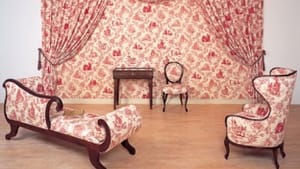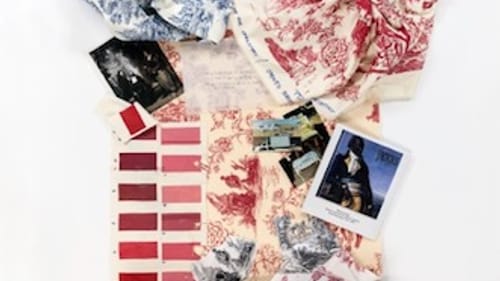Stay in the Loop
BSR publishes on a weekly schedule, with an email newsletter every Wednesday and Thursday morning. There’s no paywall, and subscribing is always free.
Digging into inspiration
Fabric Workshop and Museum's 'Process and Practice: 40 Years of Experimentation'

To celebrate the Fabric Workshop and Museum’s (FWM) 40th anniversary, something special was needed. Susan Lubowsky Talbott, who has led FWM since the 2015 death of the institution’s founder, Marion Boulton “Kippy” Stroud, took a deep dive into its archives and came up with Process and Practice: 40 Years of Experimentation.
FWM’s archives consist of 371 boxes of leftover inspiration wrapped in tissue. “It was like Christmas. Every box was a gift,” Talbott recalls. After all, as its name suggests, FWM does more than present contemporary art. “We both make and present,” she says.
Art making, revealed
Arriving at FWM, Talbott reviewed both permanent collection and archives. She compares the experience to an archaeological dig. The search yielded an ideal way to curate the anniversary exhibit: put method and result on display by pairing finished works with what led to them.
For four decades, artists completing residencies at FWM gave the institution the creative detritus of finished projects, tucking it all into large flat boxes. The boxes now provide a survey of contemporary art in the late 20th and early 21st centuries. Some reveal experimentation by known artists, others the beginnings of iconic careers. Among the 84 artists on display are Laurie Anderson, Dale Chihuly, Roy Lichtenstein, and Claes Oldenburg.
Failure is an option
“The artist-in-residence program gives artists the opportunity to fail, and to pursue dream projects they couldn’t do on their own. . . . Artists can come here without fear of failure, and that opens all kinds of channels for them,” Talbott says.
In 1984, Louise Nevelson came to FWM with a commission from the Opera Theater of Saint Louis to design costumes and sets for its production of Orfeo ed Euridice. It would be the sculptor’s first time designing for the stage, at the age of 85. She worked with a silkscreen-printing process to produce 40 costumes, no two alike. The one displayed, “Opera Costume” (1985) is a funnel-necked 5.5-foot square of cotton twill printed with abstract black brushstrokes over a gray marbled background. The simple lines and palette, as well as the varied brushwork, suggest Japanese shodo calligraphy.
Imagining lightbulb moments
Exhibited items defy categorization, and anyway, that’s not the point of this exhibit, or really any at FWM. Process and Practice is about what happens before work arrives in a gallery; it lets us peek over an artist’s shoulder as an idea takes wing. The archival boxes are like incubators, and it’s fun to toggle between them and the finished works to see which details persisted and which were discarded.

The never-before-seen source material is displayed in cases near the resulting works. There are items used for research and communication, photographs and books, handwritten notes, sketches, and models sent from artists to FWM studio staff. The staff are also skilled in-house artists who assist with patternmaking, printing, sewing, and other tasks. They make it possible for artists to pursue unfamiliar media or take on projects requiring many hands.
Boxes also hold project-specific items, such as fishing nets, razor wire, silk flowers, BB guns, silver spoons, and hog intestines. The hog intestines, by the way, not only made the final cut but are the central theme of Miroslaw Balka’s “Hog Intestine and Aluminum” (1997). Balka envisioned the finished work as two amber cylinders the size of a person: a pair of porky pillars standing side-by-side on the gallery floor.
Covers for ducking, and subversive toile
Robert Morris’ 1981 “Restless Sleepers/Atomic Shroud” is uncomfortably timely. Working materials include printed images and text on linen. The finished piece is a double bed ready for a nuclear winter’s nap.
There’s a coverlet, white linen imprinted with black-and-white images of mushroom clouds, and two pillows inscribed with a passage that should be narrated by Robert Oppenheimer: “It would be difficult to achieve erasure with a single thermonuclear device, given the present state of technology…” Sweet dreams, indeed.
Renée Green put an awakened spin on 17th-century fabric toile. At first glance, the design of the wallpaper, draperies, chaise longue, and chairs comprising “Mise-en-Scène: Commemorative Toile” (1992), seems to be the expected medallion pattern. But instead of idyllic vignettes of European gentry, Green shows us scenes of rebellion in blood-red-and-white on cotton sateen. The work is inspired by the book The Image of the Black in Western Art, the cover of which is included in Green’s archival box, along with swatches of traditional toile, a color chart, photographs of sample furniture, and notes to FWM staff.
The exhibit does justice to FWM’s unique role as an art presenter and catalyst. Despite Stroud’s unexpected death, FWM is thriving at 40. Due to its expanded programming, attendance has doubled in the past two years. Because of partnerships forged with other arts institutions in the region, including Moore College of Art and Design, the University of Pennsylvania, Temple University’s Tyler School of Art, and the Center for Architecture (which collaborated on the recent Louis Kahn exhibition), more people are visiting.
According to Talbott, FWM is financially stable, securing grants from major private and public funders. It is also beloved among the artists it has nurtured. In all, it sounds like a legacy that would make Kippy Stroud proud.
What, When, Where
Process and Practice: 40 Years of Experimentation. Through March 25, 2018, at the Fabric Workship and Museum, 1214 Arch Street, Philadelphia. (215) 561-8888 or fabricworkshopandmuseum.org.
Sign up for our newsletter
All of the week's new articles, all in one place. Sign up for the free weekly BSR newsletters, and don't miss a conversation.